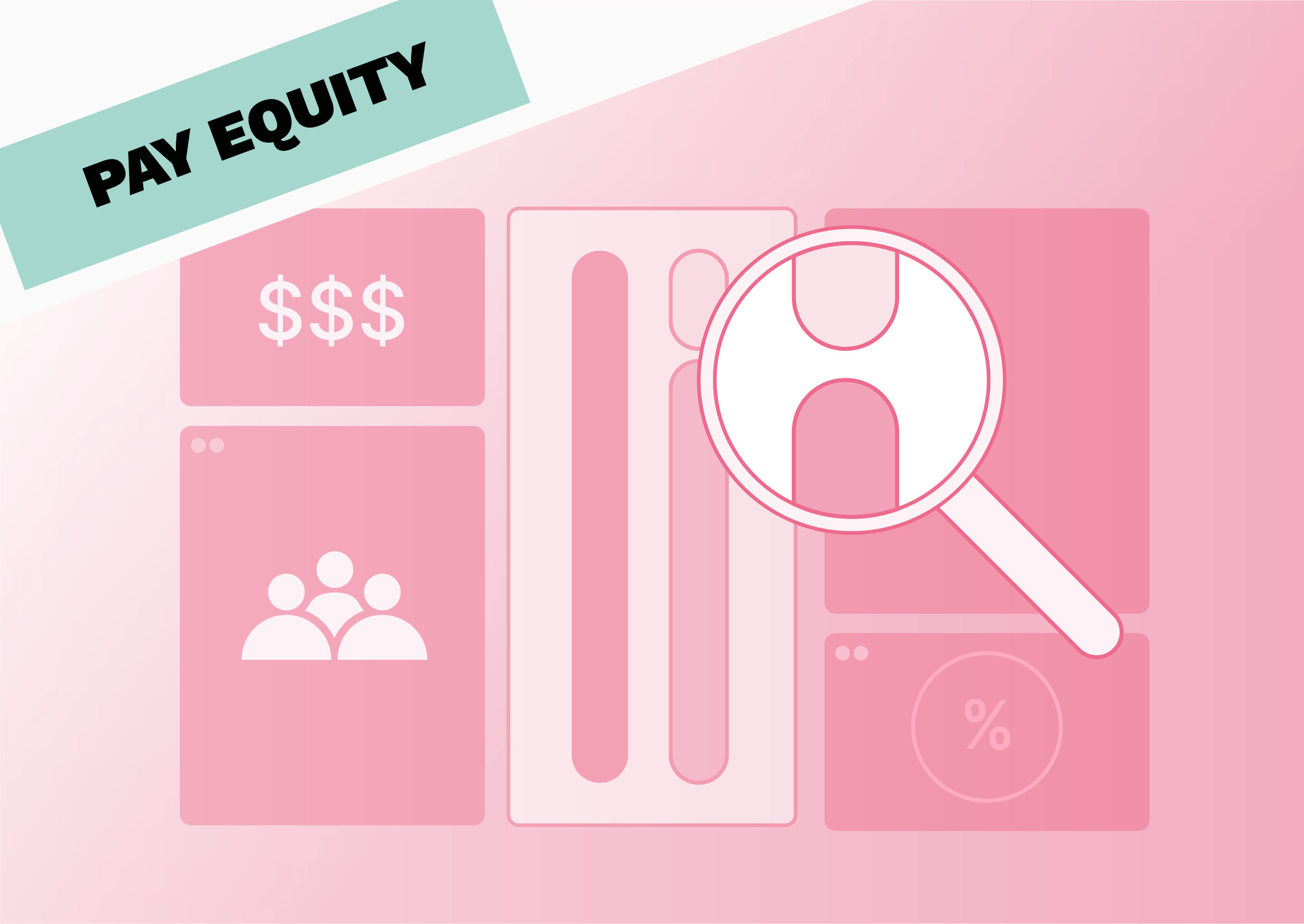Unconscious bias can have a significant impact on pay equity within an organisation. And, since it’s unconscious by definition, it can be a tricky problem to solve. After all, how can you ask people to stop doing something they’re not even aware of?
While it may not be possible to fully stamp out unconscious bias, there are some things you can do to mitigate its impact on compensation decisions — we’ll explore some key strategies in this article.
Understanding pay equity
Pay equity is the concept of paying employees the same amount if they do the same or similar work. In law, the key concept to understand is ‘equal pay for work of equal value’. This means we’re not just talking about employees who share the same job title, but also those who have a substantially similar function within a business in terms of their duties, level of responsibility and working conditions.
One way of measuring pay equity — either within an organisation or a country — is the gender pay gap. This is the percentage difference between the average pay received by all men compared to all women. As of November 2023, the average gender pay gap in the EU is 13%.
The gender pay gap can be partially explained by systemic factors. For example, professions that are generally dominated by men tend to be higher paid than those favoured by women. Women are also more likely to take time out of work to have children and to opt for jobs with flexible schedules to accommodate family responsibilities.
These are obviously big problems — but they can’t be solved by individual employers. However, there is still a gender pay gap even when these factors are accounted for. That means that, in some organisations, women are being paid less than men for the same work — and unconscious bias could be the reason.
What is unconscious bias?
Unconscious bias refers to the associations and assumptions that our brains make without us being aware of them. It’s built on stereotypes about certain groups and tends to result in favouring people who are more like us over those who are different. Whether we like it or not, unconscious bias exists in all of us.
Bias can impact workplace decisions related to hiring, promotions, work assignments and compensation. And, because it’s unconscious, this can happen without us even realising it. That means that in some organisations, managers and leaders perpetuate inequitable pay while fully believing that they’re acting fairly.
How unconscious bias can impact pay equity
Unconscious bias can impact various HR processes including recruitment, performance evaluations, training opportunities, promotions and pay increases.
For example, one study found that hiring managers were much more likely to favour candidates with ‘white-sounding’ names, even when resumes were identical. In another study, science faculty members rated male applicants as significantly more competent and hireable than female ones. They also selected a higher starting salary for male candidates and offered them more career mentoring.
The people involved in these experiments probably weren’t aware of the biases impacting their decisions. According to a resource from the University of California San Francisco, unconscious bias is a lot more prevalent than conscious prejudice, and it can even be incompatible with a person’s conscious values. All of this means that a person doesn’t necessarily have to be acting in bad faith for unconscious bias to shape the decisions they make.
The problem with unconscious bias training
Offering unconscious bias training for leaders and managers is often the first step that companies take when trying to improve pay equity. However, unconscious behaviour is notoriously difficult to change. While participants might be able to easily identify bias in a training setting, there’s no guarantee that this will translate to their day-to-day interactions.
In fact, there’s even evidence that raising awareness of stereotypes in the workplace can increase the use of those stereotypes — making the situation even worse. In some cases, employers see training as a box-ticking exercise, and employees believe they no longer have to worry about unconscious bias once they’ve completed the training.
This isn’t to say that unconscious bias training is completely useless. Training that encourages employees to acknowledge and reflect on their biases can at least make them more aware of the factors that could impact their decisions. However, training is only effective if it’s part of a broader, long-term strategy that includes structural changes and ongoing feedback.
{{cta}}
Mitigating the impact of unconscious bias: 5 key strategies
Most people don’t realise when their decisions are influenced by unconscious bias. It’s called ‘unconscious’ for a reason, after all. But, while we may not be able to get rid of unconscious bias altogether, we can take action to reduce its impact on pay decisions within an organisation.
By putting in place the right checks and balances, employers can improve pay equity by ensuring pay decisions are based on objective criteria and not influenced by bias. Here are a few strategies to try:
1. Implement a clear and consistent pay structure
First things first: true pay equity is only possible when compensation is built around a clear and consistent structure. That means organisations should have a clearly designed job architecture and levelling framework that defines each role according to the duties and level of responsibility that it involves.
Putting in place salary bands for each role and level (and ensuring that these are adhered to) can also help you to keep things fair. While it’s reasonable to have small pay differences to account for things like performance, location and seniority, these should be clearly defined as part of your overall compensation policy.
2. Review and redesign your hiring processes
Unconscious bias can have a significant impact on the hiring process. The first step in combating it is to review your job descriptions for biased language. For example, studies have shown that female candidates are often put off by ‘male-coded’ language like ‘leading’, ‘competitive’, or ‘active’. Removing these can help you to attract more diverse candidates.
It’s also important to ensure that hiring decisions are made according to objective, gender-neutral criteria. Be wary of nebulous concepts like ‘culture fit’, which can often conceal unconscious bias. Putting together diverse hiring panels can help you to ensure that a wide range of views and opinions are taken into account.
{{cta}}
3. Set clear criteria for promotions and increases
The way pay rises and promotions are awarded in your organisation can significantly impact overall pay equity. If managers rely on subjective assessments of performance and effort, unconscious bias may come into play.
This can lead to women and other marginalised groups being promoted less frequently than their white male counterparts. Over time, this lack of advancement compounds, resulting in these employees earning considerably less by the end of their careers.
For the most part, managers aren’t doing this on purpose, and many may truly believe their decisions are objective. The only way to combat this issue is to put in place clear, standardised criteria for promotions and pay rises, using tools like performance metrics and 360-degree feedback.
4. Conduct regular pay equity audits
Even with the best intentions, companies can still face issues with pay equity. That’s why it’s essential to regularly audit your organisation’s pay practices. A pay equity audit involves reviewing your pay structures and processes to identify any disparities and understand the reasons behind them.
Conducting a pay equity audit is a lot of work — but it’s well worth the effort. Regular audits help you to identify inequities that might otherwise have gone unnoticed and correct them as quickly as possible. This ensures your overall pay practices are equitable and fair.
5. Promote pay transparency
When pay is transparent, employees can more easily assess whether they’re being paid fairly. And companies that openly share their pay practices are also incentivised to ensure each pay decision is based on objective criteria, simply because they can’t get away with not doing so.
Many employers are understandably wary about opening up their pay practices to public scrutiny. But the reality is that they soon won’t have a choice: the EU Pay Transparency Directive is set to come into force by 2026 and will require significant changes in how companies handle pay. Better to get ahead now and ensure your pay practices are in line before transparency becomes a legal obligation.
{{cta}}
The key to fair and equitable compensation
Unconscious bias is a tricky thing to eliminate simply because it happens without us even being aware of it. Most managers don’t set out to make unfair decisions about pay — but many are unaware of the various assumptions and associations that are shaping their decisions.
Instead of trying to banish unconscious bias, the best way to limit its impact on pay equity is to put in place a system of robust checks and balances that ensure pay decisions are fair and consistent. To achieve this, you need the right tools.
Figures is an all-in-one compensation management system that allows you to benchmark salaries against the market, create robust and scalable compensation structures and even run smoother, more effective compensation reviews. In short, Figures gives you everything you need for fair, equitable compensation.
Summarize this article with AI
No time to read it all? Get a clear, structured, and actionable summary in one click.






